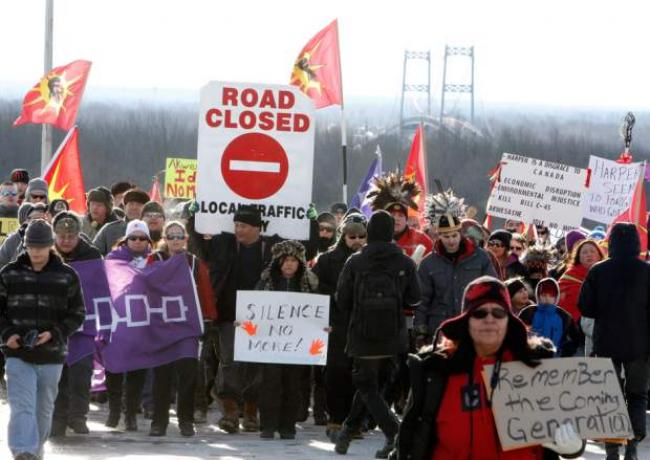Articles Menu

The Trudeau government says Canada’s national police force respects the right to peaceful demonstrations by indigenous activists, after it was revealed the RCMP compiled a list and distributed profiles of indigenous protesters it deemed “threats” who it determined were potentially willing and capable of criminal activities.
Dubbed Project SITKA, the RCMP began soliciting information on indigenous activists who could be perceived “to have committed or commit” crimes from all of its divisions and local police departments across the country in March 2014.
Using the information it received and data collected from social media, the Mounties identified 313 activists — attendees of protests on issues ranging from natural resource development to missing and murdered indigenous women — who potentially posed a “criminal threat to Aboriginal public order events.”

The RCMP then narrowed that list to 89 individuals it said met “the criteria for criminality” and created unique profiles for each one. These profiles were then made available to front-line officers, analysts and other law enforcement agencies through two police databases, the RCMP’s Automated Intelligence Information System and the Police Reporting and Occurrence System.
Included in the profiles on the individuals were their names, photographs, aliases, birthdates, phone numbers, email addresses, organizational affiliations, vehicles they drove, a five-year history of demonstrations they attended, and information on their mobility throughout Canada. Each was also assigned a “category of protester”: “passive” (“law-abiding”), “disruptive” (“law-resisting”) or “volatile” (“violence-prone”).
It is unclear whether the individuals monitored had committed a crime when the RCMP began tracking them under Project SITKA. The RCMP did not reply to a request for comment.
An RCMP report on the project, completed in March 2015 by its National Intelligence Coordination Centre, says it was designed to provide a “snapshot of individual threats.”

“The Canadian government and security establishment viewed the targeting of critical infrastructure — in the form of highways, railways and border crossings — during the height of Idle No More, as well as the blockade of SWN Resources equipment during shale gas exploration efforts in southeastern New Brunswick — as a threat to national security and its natural resources development agenda,” said Andy Crosby, a researcher who obtained the RCMP report under an Access to Information request, along with Carleton University criminology professor Jeffrey Monaghan.
The Mounties’ activities were condemned by human rights groups, including Canadian Journalists for Free Expression, who argued Project SITKA was undertaken without reasonable grounds and in violation of the Charter rights to freedom of expression and privacy of those who were profiled.

“Innocent advocates were investigated and catalogued based on little more than a perceived potential threat that their expression might pose to the state,” said CJFE, in a statement.
“Despite law enforcement surveillance requiring a reasonable suspicion for criminal activity, the RCMP unreasonably targeted citizens affiliated with groups, political movements, ideologies and forms of expression that are protected.”
A spokesperson for Public Safety Minister Ralph Goodale said Project SITKA was focused on identifying potential threats to public safety at indigenous events and protests.
“This focus was in keeping with recommendations stemming from the 2007 Ipperwash Inquiry report, which highlighted the need to examine aboriginal protests as a separate and distinctive form of protest requiring dedicated and unique police resources, strategies and responses,” said Scott Bardsley.
Bardsley added that the report on Project SITKA concluded there were no direct threats to critical infrastructure and no connection to organized crime associated with Indigenous protests.
This raises ongoing concerns surrounding the blurring of indigenous land defence and environmental protests as domestic extremism and eco-terrorism, even if the RCMP wants to move beyond using this language.
The report recommended that the federal police force should cease classifying indigenous activists in the category of terrorism and extremism, and should instead create a dedicated category of intelligence gathering for indigenous protests and activism. It also recommended that the RCMP should keep profiles on select indigenous activists in police databases.
However, according to Crosby, the recommendation to examine indigenous activism separately is not without potential consequence.
“This raises ongoing concerns surrounding the blurring of indigenous land defence and environmental protests as domestic extremism and eco-terrorism, even if the RCMP wants to move beyond using this language,” he said.
“It subjects those protecting the land and water to an intensified and pervasive surveillance regime where law enforcement develops permanent profile databases, which have the effect of criminalizing individuals where in many cases no crimes have been committed.”
Crosby added that it is likely the information collected on the 313 individuals deemed “individual threats,” including the 89 given full profiles, is retained, stored in databases and shared among law enforcement and industry partners.
Of the 89 individuals profiled under Project SITKA, 35 were from New Brunswick, suggesting activists involved with protests by members of the Elsipogtog First Nation in 2013 were heavily scrutinized. The Civilian Complaints Commission that reviews RCMP conduct received hundreds of complaints about the behaviour of officers at the anti-fracking protests, including allegations of use of excessive force, uttering racist language, unreasonable detention and arrest without sufficient grounds.
British Columbia was second with 16 people on the list, Ontario had 15, Manitoba 11, Nova Scotia 10 and there was one each from Saskatchewan and Prince Edward Island.
The RCMP previously began collecting data on indigenous protesters in 2007, but later said that its unit formed to collect intelligence on indigenous “civil disobedience and unrest in the form of protest actions” was shuttered in 2010.
In 2012, the police force was again revealed to have spied on a coalition of British Columbia First Nations opposed to the Enbridge Northern Gateway Pipelines, including the monitoring of private meetings they held with environmental groups.
[Top photo: First Nations Idle No More protestors march and block the International Bridge between the Canada and U.S. border near Cornwall Ontario, Saturday January 5 2013., THE CANADIAN PRESS/Fred Chartrand/File]